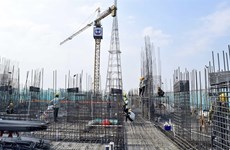Economic restructuring brings opportunities to investors
Investment opportunities from the equitisation of state-owned
enterprises (SOEs), the acquisition of bad debts and investment in the
consumer goods and retail sectors are of great interest to experts and
investors in the current context, said the Vietnam Economic News.
Investment opportunities from the equitisation of state-owned
enterprises (SOEs), the acquisition of bad debts and investment in the
consumer goods and retail sectors are of great interest to experts and
investors in the current context, said the Vietnam Economic News.
The Vietnamese securities market is said to offer great potential compared with other Southeast Asian countries and the equitisation of SOEs has attracted great attention from domestic and foreign investment funds.
So far, Vietnam has equitised 4,100 SOEs. Under the Prime Minister’s guidance, 432 SOEs must be equitised in 2014 and 2015. These include the Vietnam National Textile and Garment Group (Vinatex), three corporations established under Prime Ministerial Decision 91/TTg (Vietnam Airlines Corporation, Vietnam Cement Industry Corporation and Vietnam National Shipping Lines (Vinalines), 54 corporations established pursuant to Prime Ministerial Decision 90/TTg, and SOEs managed by different ministries, sectors and localities.
Nguyen Trong Dung, Director of the Government Office’s Department of Business Innovation, said that by September 10, 2014, the Prime Minister, ministries and sectors have approved the equitisation plans of 65 SOEs including Vinatex and Vietnam Airlines. Vietnam Airlines’ equitisation plan was approved on September 10 with chartered capital of 14 trillion VND, 75 percent of which will be held by the state, 20 percent will be sold to strategic shareholders and five percent made available to other shareholders.
The acceleration of the equitisation of SOEs will make the Vietnamese securities market more attractive in the time to come.
Central Institute for Economic Management Deputy Director Vo Tri Thanh said that the Government had showed a strong will to accelerate the equitisation of SOEs, but the evaluation of SOEs had faced numerous difficulties related to land as well as difficulties in looking for strategic partners. In the equitisation process, SOEs also have to cope with social problems related to employees and the pressure to list their shares on the securities market.
Along with accelerating SOE equitisation, many investors have paid special attention to dealing with bad debts. According to Dr. Tran Du Lich, member of the National Assembly’s Economic Committee, by August 2014, about 210 trillion VND of bad debts have been dealt with and 161 trillion VND remained unresolved (including newly arisen bad debts). Bad debts have become a macroeconomic problem of great concern to the government, he emphasised.
Therefore, the debt acquisition market in Vietnam currently offers investors many opportunities. Nguyen Khac Hai, Deputy General Director of the SSI Asset Management Company, said that the company had received many proposals from reputable foreign institutions regarding the association with Vietnamese partners in resolving bad debts but no action had been taken due to mechanism-related difficulties. Currently, the Vietnam Asset Management Company (VAMC), the debt management company of the Ministry of Finance and asset management companies of banks are allowed to be involved in debt acquisitions.
The Vietnamese economy has shown clear signs of recovery. Foreign financial investors are seeking opportunities to directly invest in different sectors of the Vietnamese economy.
The Vietnam Economic News quoted George Joseph Ghorra from the International Finance Corporation (IFC) - a member of the World Bank Group, as saying that in the recent period, IFC had invested in six different asset management company funds in Vietnam and most of its investment capital had flowed into the financial market. Compared with other markets in Southeast Asia, the Vietnamese securities market currently offers investors many favorable conditions. Vietnam also offers many investment opportunities in the banking sector as well as through merger and acquisition (M&A) deals.
Other sectors such as consumer goods, retail, education, banking, hydropower and renewable energy also offer investors big opportunities.
Saigon Co.op Chairman Nguyen Ngoc Hoa, said that the Vietnamese modern retail sector offered good prospects based on factors such as population and per-capita income growth and increasing middle class. Despite a slowdown in its growth in recent years, the Ministry of Industry and Trade has set a target to increase the percentage of modern retail outlets from 22 percent to 45 percent of total retail sales by 2020. Vietnam expects to have 1,200-1,300 supermarkets and 337 shopping centres by 2020. This means from now to 2020, Vietnam will have to develop an additional 550 supermarkets and 200 shopping centres, offering retail investors big opportunities.-VNA
The Vietnamese securities market is said to offer great potential compared with other Southeast Asian countries and the equitisation of SOEs has attracted great attention from domestic and foreign investment funds.
So far, Vietnam has equitised 4,100 SOEs. Under the Prime Minister’s guidance, 432 SOEs must be equitised in 2014 and 2015. These include the Vietnam National Textile and Garment Group (Vinatex), three corporations established under Prime Ministerial Decision 91/TTg (Vietnam Airlines Corporation, Vietnam Cement Industry Corporation and Vietnam National Shipping Lines (Vinalines), 54 corporations established pursuant to Prime Ministerial Decision 90/TTg, and SOEs managed by different ministries, sectors and localities.
Nguyen Trong Dung, Director of the Government Office’s Department of Business Innovation, said that by September 10, 2014, the Prime Minister, ministries and sectors have approved the equitisation plans of 65 SOEs including Vinatex and Vietnam Airlines. Vietnam Airlines’ equitisation plan was approved on September 10 with chartered capital of 14 trillion VND, 75 percent of which will be held by the state, 20 percent will be sold to strategic shareholders and five percent made available to other shareholders.
The acceleration of the equitisation of SOEs will make the Vietnamese securities market more attractive in the time to come.
Central Institute for Economic Management Deputy Director Vo Tri Thanh said that the Government had showed a strong will to accelerate the equitisation of SOEs, but the evaluation of SOEs had faced numerous difficulties related to land as well as difficulties in looking for strategic partners. In the equitisation process, SOEs also have to cope with social problems related to employees and the pressure to list their shares on the securities market.
Along with accelerating SOE equitisation, many investors have paid special attention to dealing with bad debts. According to Dr. Tran Du Lich, member of the National Assembly’s Economic Committee, by August 2014, about 210 trillion VND of bad debts have been dealt with and 161 trillion VND remained unresolved (including newly arisen bad debts). Bad debts have become a macroeconomic problem of great concern to the government, he emphasised.
Therefore, the debt acquisition market in Vietnam currently offers investors many opportunities. Nguyen Khac Hai, Deputy General Director of the SSI Asset Management Company, said that the company had received many proposals from reputable foreign institutions regarding the association with Vietnamese partners in resolving bad debts but no action had been taken due to mechanism-related difficulties. Currently, the Vietnam Asset Management Company (VAMC), the debt management company of the Ministry of Finance and asset management companies of banks are allowed to be involved in debt acquisitions.
The Vietnamese economy has shown clear signs of recovery. Foreign financial investors are seeking opportunities to directly invest in different sectors of the Vietnamese economy.
The Vietnam Economic News quoted George Joseph Ghorra from the International Finance Corporation (IFC) - a member of the World Bank Group, as saying that in the recent period, IFC had invested in six different asset management company funds in Vietnam and most of its investment capital had flowed into the financial market. Compared with other markets in Southeast Asia, the Vietnamese securities market currently offers investors many favorable conditions. Vietnam also offers many investment opportunities in the banking sector as well as through merger and acquisition (M&A) deals.
Other sectors such as consumer goods, retail, education, banking, hydropower and renewable energy also offer investors big opportunities.
Saigon Co.op Chairman Nguyen Ngoc Hoa, said that the Vietnamese modern retail sector offered good prospects based on factors such as population and per-capita income growth and increasing middle class. Despite a slowdown in its growth in recent years, the Ministry of Industry and Trade has set a target to increase the percentage of modern retail outlets from 22 percent to 45 percent of total retail sales by 2020. Vietnam expects to have 1,200-1,300 supermarkets and 337 shopping centres by 2020. This means from now to 2020, Vietnam will have to develop an additional 550 supermarkets and 200 shopping centres, offering retail investors big opportunities.-VNA












